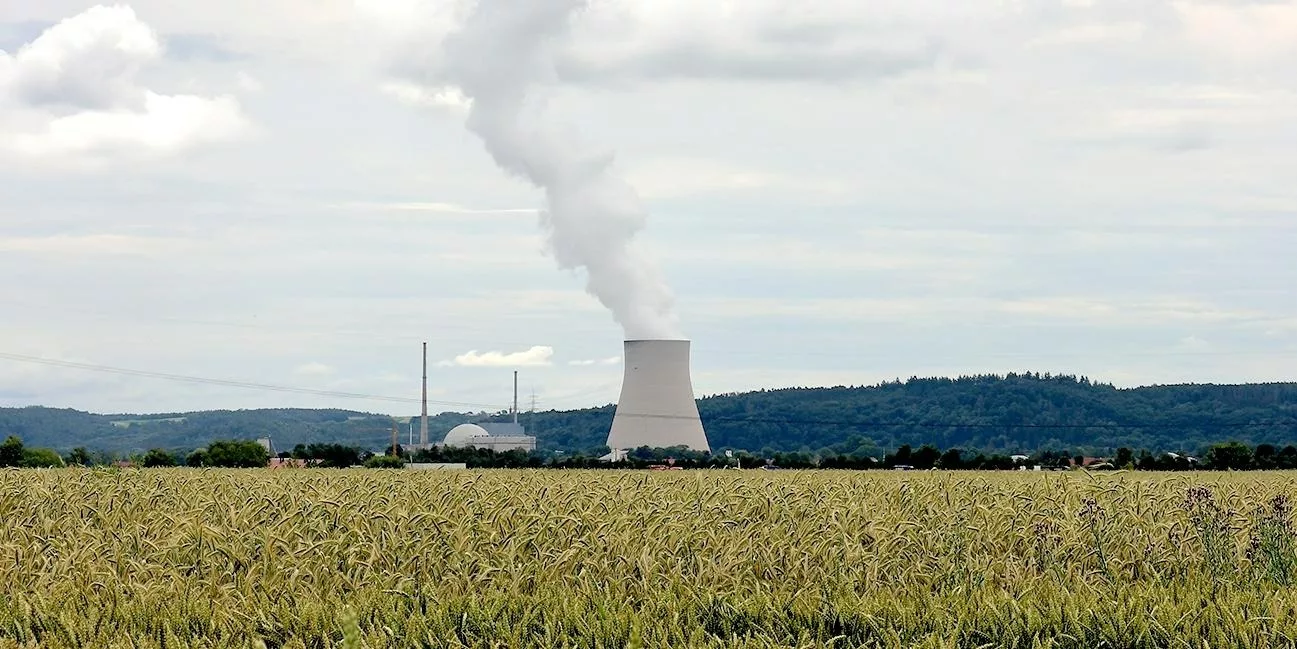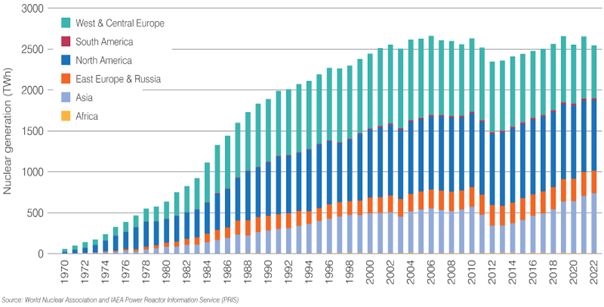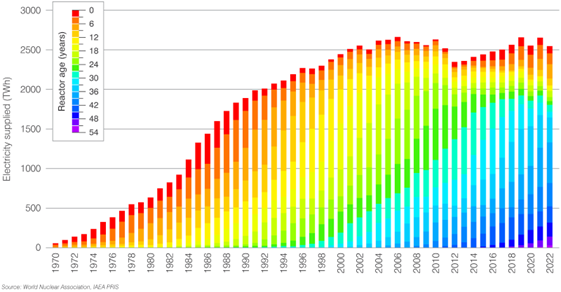
Global Nuclear Energy: The current and future horizons
Exploring the global impact of nuclear energy on electricity production and climate goals.
How is nuclear power shaping the future.
Nuclear energy plays a vital role as a low-emission electricity source, contributing approximately 10% to global electricity production. In countries where it is produced, it complements renewable energy sources, aiding in the reduction of emissions in the power sector, and enhances electricity security as a reliable power source. Additionally, nuclear power can be used for producing low-emission heat and hydrogen. However, substantial efforts are required to align nuclear power with the Net Zero Emissions by 2050 Scenario. Extending the operational life of existing nuclear plants stands out as one of the most cost-effective methods for generating low-emission electricity. Encouragingly, several favorable policy developments have emerged in countries such as the United States, France, and Japan, aiming to fully exploit these opportunities.
To expedite progress, further initiatives are necessary to boost the construction of new nuclear facilities. While 8 GW of new nuclear capacity came online in 2022, the Net Zero Scenario calls for an annual deployment exceeding four times that amount by 2030.
Supporting innovation in nuclear power, which includes the development of small modular reactors, will also play a crucial role. Such endeavors will broaden the array of low-emission options available and pave the way for achieving a net-zero power sector.
During the current global energy challenges, reducing our dependence on imported fossil fuels has taken center stage as the foremost energy security concern. Equally critical is addressing the climate crisis, where achieving net-zero greenhouse gas emissions by mid-century necessitates a swift and comprehensive decarbonisation of electricity generation and heat production. Nuclear energy, operating in 32 countries with a combined capacity of approximately 413 gigawatts (GW), plays a pivotal role in advancing both of these objectives. It helps mitigate climate change by preventing the release of 1.5 gigatonnes (Gt) of global emissions annually and reduces global gas demand by 180 billion cubic meters (bcm) each year.
History of Nuclear Power
Nuclear technology uses the energy derived from the division of specific elements’ atomic nuclei. Its inception dates back to the 1940s when initial research primarily centered on creating explosive devices during World War II. However, in the 1950s, the emphasis shifted towards the peaceful utilization of nuclear fission, aimed at regulating it for electricity production.
Civil nuclear power has accumulated over 18,000 years of reactor operation experience, with operational nuclear power facilities spanning 32 countries across the globe. Additionally, numerous other nations rely partially on nuclear-generated electricity via regional transmission grids. Notably, countries like Italy and Denmark derive nearly 10% of their electricity from imported nuclear power sources.
In 2022, thirteen nations generated a minimum of 25% of their electricity from nuclear sources. France leads the way, with nuclear energy accounting for approximately 70% of its electricity production. Meanwhile, Ukraine, Slovakia, Belgium, and Hungary derive roughly half of their electricity from nuclear power. Japan, which historically depended on nuclear energy for over a quarter of its electricity, is expected to gradually restore a similar level of reliance on nuclear power.

Figure 1. Nuclear electricity production in TWh by region
Need for more nuclear power generation:
New generating capacity is clearly in demand worldwide. This demand arises from the need to replace aging fossil fuel power plants, particularly coal-fired ones that emit substantial amounts of carbon dioxide. It’s essential to satisfy the growing electricity requirements in many countries.
In 2022, nuclear reactors produced 2545 TWh in total, with an expected 59 TWh coming from Ukraine. This is 108 TWh less than the 2653 TWh in 2021. Nuclear generation, excluding Ukraine, was 2487 TWh in 2022, a decrease of 85.4 TWh from the comparable amount in 2021.
In Asia, nuclear energy generation rose by 37 TWh in 2022. Although there were slight declines in South America and Africa, overall output was still within the range of recent years for these regions. The 6 TWh drop in output in North America was a result of Palisades’ closure. In East Europe and Russia, output fell by 22 TWh, which is comparable to the expected loss in generation in Ukraine. West and Central European generation fell by 112 TWh, with a 34 TWh decrease in output in Germany due to reactor closures and an 81 TWh decrease in output in France due to a significant number of reactor outages.
The OECD International Energy Agency regularly releases energy-related scenarios, including the 2022 World Energy Outlook. This publication features an ambitious “Net Zero Emissions by 2050 Scenario” (NZE), which outlines a path toward stabilizing the global average temperature increase at 1.5°C while ensuring universal access to modern energy by 2030. In the NZE outlined in the WEO 2022, nuclear capacity is projected to grow to 871 gigawatts (GWe) by the year 2050.

Figure 2. Total global nuclear electricity generation by age of reactor
A worldwide overview
The following details some select instances on how nuclear power is being developed around the world.
In North America:
Canada operates 19 nuclear reactors with a total net capacity of 13.6 gigawatts (GWe). Meanwhile, Mexico operates two nuclear reactors with a combined net capacity of 1.6 GWe, contributing 5.3% to its electricity generation in 2022. In contrast, the United States boasts 93 operational nuclear reactors with a total net capacity of 95.8 GWe, making nuclear power responsible for 19.6% of its electricity production.
In the USA, there were originally four AP1000 reactors under construction, but two of them have been canceled. The reduced emphasis on new nuclear construction in the United States can be attributed in part to the remarkable success in improving maintenance strategies. Over the past 15 years, enhanced operational performance has led to greater utilization of existing nuclear power plants, with the increased output equivalent to the generation capacity of 19 new 1000-megawatt electric (MWe) plants.
Although a new nuclear power reactor began operation in 2016, the total number of operational reactors has decreased in recent years from a peak of 104 in 2012. These early closures can be attributed to a combination of factors, including the availability of cheap natural gas, market liberalization, excessive subsidies for renewable energy sources, and political advocacy.
In South America:
Argentina operates three nuclear reactors with a total net capacity of 1.6 gigawatts electric (GWe), contributing 7.2% to its electricity generation in 2022. Brazil has two nuclear reactors with a combined net capacity of 1.9 GWe, accounting for 2.4% of the country’s electricity generation in the same year.
In West and Central Europe:
Belgium operates seven nuclear reactors with a combined net capacity of 5.9 gigawatts electric (GWe), making nuclear power responsible for 50.8% of the country’s electricity generation in 2022.
Finland has five operational nuclear reactors with a total net capacity of 4.4 GWe, contributing 32.8% to its electricity generation in 2022. Notably, Finland’s fifth reactor, a 1600 MWe (net) EPR, was connected to the grid in March 2022.
France stands out with a significant nuclear presence, housing 56 operational nuclear reactors with a combined net capacity of 61.4 GWe. In 2022, nuclear power accounted for 69.0% of the country’s electricity generation. Initially, a 2015 energy policy aimed to reduce the share of nuclear generation to 50% by 2025, but this target has been postponed to 2035 because of concerns about its feasibility, potential increase in carbon dioxide emissions, threats to energy security, and job stability. France is also constructing one reactor–a 1750 MWe EPR at Flamanville.
The Netherlands has a single operational nuclear reactor with a net capacity of 0.5 GWe, contributing 3.1% to the country’s electricity generation in 2022.
Spain operates seven nuclear reactors with a combined net capacity of 7.1 GWe, making nuclear power responsible for 20.8% of the country’s electricity generation in 2022.
Sweden boasts six operational nuclear reactors with a total net capacity of 6.9 GWe, contributing 30.8% to its electricity generation in 2022. While some older reactors are being phased out, Sweden has made substantial investments in extending the operating lifetimes and enhancing their performance.
Switzerland relies on four operational nuclear reactors with a combined net capacity of 3.0 GWe, accounting for 28.8% of the country’s electricity generation in 2022.
The United Kingdom operates nine nuclear reactors with a combined net capacity of 5.9 GWe, contributing 14.8% to the country’s electricity generation in 2022.
In Central and Eastern Europe, including Russia:
Armenia relies on a solitary nuclear power reactor with a net capacity of 0.4 gigawatts electric (GWe), which generated 25.3% of the country’s electricity in 2022.
Belarus operates two operational nuclear power reactors with a combined net capacity of 2.2 GWe, accounting for 14.1% of the country’s electricity generation in 2021. Most Belarus’s electricity comes from natural gas.
Bulgaria maintains two operational nuclear reactors with a combined net capacity of 2.0 GWe, contributing 34.6% to the country’s electricity generation in 2021.
The Czech Republic operates six operational nuclear reactors with a total net capacity of 3.9 GWe, making nuclear power responsible for 36.6% of the country’s electricity generation in 2021.
Hungary possesses four operational nuclear reactors with a combined net capacity of 1.9 GWe, contributing 46.8% to the country’s electricity generation in 2021.
Romania operates two operational nuclear reactors with a combined net capacity of 1.3 GWe, accounting for 18.5% of the country’s electricity generation in 2021.
Russia has an extensive nuclear infrastructure, boasting 37 operational nuclear reactors with a combined net capacity of 27.7 GWe, which contributed 20.0% to the country’s electricity generation in 2021. In 2016, a government decree outlined plans to construct 11 additional nuclear power reactors by 2030, supplementing those already under construction. As of the beginning of 2022, Russia had three reactors under construction, with a combined capacity of 2.6 GWe. Russia’s nuclear industry also holds a dominant position in global export markets, taking part in new reactor projects in various countries, including Belarus, China, Hungary, India, Iran, and Turkey, and having varying degrees of investment in Algeria, Bangladesh, Bolivia, Indonesia, Jordan, Kazakhstan, Nigeria, South Africa, Tajikistan, Uzbekistan, and others.
Slovakia operates four operational nuclear reactors with a combined net capacity of 1.8 GWe, accounting for 52.3% of the country’s electricity generation in 2021. Two more units are currently under construction.
Slovenia maintains a single operational nuclear reactor with a net capacity of 0.7 GWe, contributing 36.9% of the country’s electricity generation in 2021.
Ukraine possesses 15 operational nuclear reactors with a combined net capacity of 13.1 GWe, making nuclear power responsible for 55.0% of the country’s electricity generation in 2021.
Turkey embarked on the construction of its inaugural nuclear power plant in April 2018, with plans for it to begin operation in 2023.
In Asia:
Bangladesh started construction on the first of two planned Russian VVER-1200 reactors in 2017, with the second reactor’s construction beginning in 2018. The country aims to have the first unit operational by 2023. Presently, most of Bangladesh’s electricity is generated from fossil fuels.
China operates a significant nuclear fleet, with 55 operational nuclear reactors boasting a combined net capacity of 53.3 gigawatts electric (GWe). In 2021, nuclear power accounted for 5.0% of the country’s electricity generation. China remains a dominant player in the global nuclear market, with 21 reactors under construction as of July 2022. Notably, in 2018, China became the first nation to commission two new reactor designs, the AP1000 and the EPR. China is also promoting the export of the Hualong One, a mostly indigenous reactor design. The need to enhance urban air quality and reduce greenhouse gas emissions motivated the drive for expanding nuclear power in China.
India maintains 22 operational nuclear reactors with a combined net capacity of 6.8 GWe, contributing 3.2% to the country’s electricity generation in 2021. The Indian government is committed to increasing its nuclear power capacity as part of a substantial infrastructure development initiative. In 2010, the government set an ambitious target to achieve 14.6 GWe of nuclear capacity online by 2024. As of July 2022, eight reactors were under construction in India, with a combined capacity of 6.7 GWe.
Japan operates 33 operational nuclear reactors with a total net capacity of 31.7 GWe. By March 2022, 10 reactors had been successfully brought back online, and another 15 were in the process of receiving restart approval following the Fukushima accident in 2011. Although nuclear power once contributed 30% of the country’s electricity, this figure dropped to just 7.2% in 2021.
South Korea maintains 25 operational nuclear reactors with a combined net capacity of 24.4 GWe, accounting for 28.0% of the country’s electricity generation in 2021. South Korea is actively constructing three new reactors domestically and a four-unit plant in the United Arab Emirates.
Pakistan operates six operational nuclear reactors with a combined net capacity of 3.3 GWe, making nuclear power responsible for 10.6% of the country’s electricity generation in 2021. Pakistan has one Chinese Hualong One unit under construction, which achieved its first criticality in February 2022.
In Africa:
Egypt started construction in July 2022 of the first of four Russian-designed VVER units at the El Dabaa site along the Mediterranean coast. Construction on the second unit began in November 2022. The expectation is that all four reactors will be operational by 2030.
South Africa operates two operational nuclear reactors with a combined net capacity of 1.9 gigawatts electric (GWe) and is the sole African nation currently generating electricity from nuclear sources. In 2021, nuclear power accounted for 6.0% of the country’s electricity generation. South Africa maintains its commitment to expanding its nuclear capacity, although significant financial challenges pose constraints on these plans.
In the Middle East:
Iran operates a solitary operational nuclear reactor with a net capacity of 0.9 gigawatts electric (GWe). In 2021, nuclear power contributed 1.0% to the country’s electricity generation. There is ongoing construction of a second Russian-designed VVER-1000 unit.
The United Arab Emirates maintains three operational nuclear reactors with a combined capacity of 4.0 GWe, and a fourth unit is currently under construction at the same Barakah plant. In 2022, nuclear power accounted for 1.3% of the country’s electricity generation.

Figure:3: Global average capacity factor
Regarding emerging nuclear energy countries:
As mentioned earlier, Bangladesh, Turkey, and the United Arab Emirates are all in the process of constructing their inaugural nuclear power plants. Several other nations are also progressing toward adopting nuclear energy for electricity generation.
Enhanced Efficiency in Operating Nuclear Reactors
The operational efficiency of nuclear reactors has made remarkable strides. Over the past four decades, a substantial increase has been witnessed in the proportion of reactors achieving high capacity factors. To illustrate, in 2022, a noteworthy 68% of reactors recorded a capacity factor exceeding 80%, a significant improvement compared to the less than 30% achieved in the 1970s. Conversely, only a mere 6% of reactors in 2022 reported a capacity factor below 50%, a marked decrease from the just over 20% recorded in the 1970s.
Other Types of Nuclear Reactors
Apart from commercial nuclear power plants, there are approximately 220 research reactors in operation for over 50 countries, with additional reactors in various stages of construction. These reactors serve purposes beyond power generation, such as research, training, and the production of medical and industrial isotopes.
The application of nuclear reactors for marine propulsion is primarily seen within major navies, where it has played a significant role for five decades by supplying power to submarines and large surface vessels. There are over 160 ships, predominantly submarines, powered by approximately 200 nuclear reactors, accumulating over 13,000 reactor years of operational experience. Both Russia and the USA have decommissioned a substantial number of their Cold War-era nuclear submarines.
Russia also boasts a fleet of substantial nuclear-powered icebreakers, with additional icebreakers under construction. Russia has successfully connected a floating nuclear power plant equipped with two 32-megawatt electric (MWe) reactors to the grid in the remote Arctic region of Pevek. These reactors are adaptations of those used to power icebreakers.
General references
World Nuclear Association, World Nuclear Performance Report 2022
